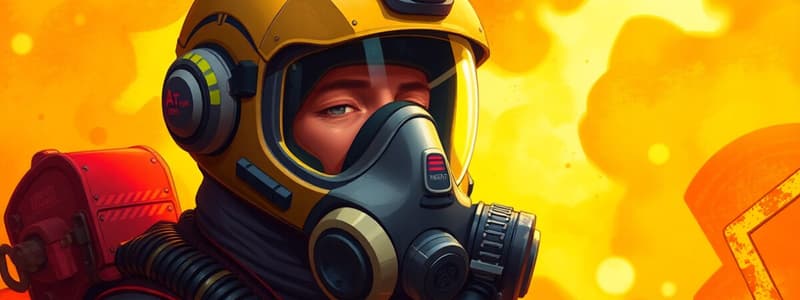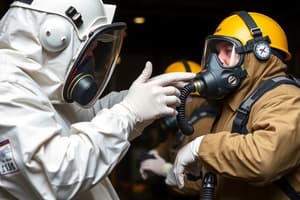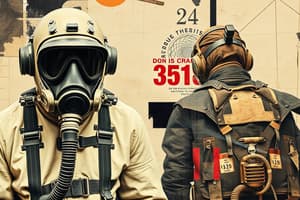Podcast
Questions and Answers
When should the SCBA be inspected?
When should the SCBA be inspected?
- Only at the beginning of a work period
- At the beginning of each work period, after use, and after cleaning (correct)
- At the end of each work period only
- Only after use and before cleaning
What is the initial step if damage to SCBA equipment is found during inspection?
What is the initial step if damage to SCBA equipment is found during inspection?
- Fill out a Safety Report immediately
- Continue using the equipment until the end of the shift
- Report the finding to the appropriate Lieutenant (correct)
- Contact the manufacturer for advice
What is the required pressure that must be maintained in the SCBA cylinder?
What is the required pressure that must be maintained in the SCBA cylinder?
- At least 100 psi (correct)
- At least 200 psi
- At least 75% of maximum pressure
- At least 90% of full capacity
What should be done if the cylinder's pressure is below 90% or 4000 psi?
What should be done if the cylinder's pressure is below 90% or 4000 psi?
What action is required if any damage is noted on the SCBA cylinder?
What action is required if any damage is noted on the SCBA cylinder?
What is the maximum allowable carbon monoxide level before self-contained breathing apparatus (SCBA) may be removed?
What is the maximum allowable carbon monoxide level before self-contained breathing apparatus (SCBA) may be removed?
How often must air produced by the Department compressor be tested?
How often must air produced by the Department compressor be tested?
Who is responsible for the management of SCBA equipment?
Who is responsible for the management of SCBA equipment?
When must members complete their annual SCBA fit test?
When must members complete their annual SCBA fit test?
Where should spare SCBA units be stored?
Where should spare SCBA units be stored?
What must be done with personal issue SCBA equipment daily?
What must be done with personal issue SCBA equipment daily?
Which facepiece is mentioned as part of the SCBA equipment?
Which facepiece is mentioned as part of the SCBA equipment?
What type of air quality must the air produced meet according to NFPA and ANSI standards?
What type of air quality must the air produced meet according to NFPA and ANSI standards?
What is the model of the self-contained breathing apparatus purchased by the department in 2016?
What is the model of the self-contained breathing apparatus purchased by the department in 2016?
What is the duration of the carbon fiber cylinder in the Scott X-3 SCBA?
What is the duration of the carbon fiber cylinder in the Scott X-3 SCBA?
Which of the following features is NOT part of the Scott X-3 SCBA?
Which of the following features is NOT part of the Scott X-3 SCBA?
Under what conditions must personnel utilize the SCBA?
Under what conditions must personnel utilize the SCBA?
Which standards do the Scott X-3 comply with?
Which standards do the Scott X-3 comply with?
What is the purpose of the daily inspection procedure outlined in the SOP?
What is the purpose of the daily inspection procedure outlined in the SOP?
Which of the following forms is required for SCBA inspection?
Which of the following forms is required for SCBA inspection?
What does the abbreviation PASS stand for in the context of the Scott X-3 SCBA?
What does the abbreviation PASS stand for in the context of the Scott X-3 SCBA?
Flashcards
SCBA Inspection
SCBA Inspection
A visual check of the SCBA equipment to identify any malfunctions, damage, or missing parts before each work period.
SCBA Cylinder Pressure
SCBA Cylinder Pressure
The required pressure for a SCBA cylinder to be in service.
Hydrostatic Test Date
Hydrostatic Test Date
The maximum time a cylinder is allowed to be in service before needing a hydrostatic test.
Damaged Missing Equipment Report
Damaged Missing Equipment Report
Signup and view all the flashcards
SCBA Technician
SCBA Technician
Signup and view all the flashcards
SCBA
SCBA
Signup and view all the flashcards
Purpose of SOP 604
Purpose of SOP 604
Signup and view all the flashcards
IDLH (Immediate Dangerous to Life and Health)
IDLH (Immediate Dangerous to Life and Health)
Signup and view all the flashcards
What type of SCBA Clearwater Fire & Rescue uses
What type of SCBA Clearwater Fire & Rescue uses
Signup and view all the flashcards
Features of the Scott X-3 SCBA
Features of the Scott X-3 SCBA
Signup and view all the flashcards
When to use SCBA
When to use SCBA
Signup and view all the flashcards
Standards for SCBA
Standards for SCBA
Signup and view all the flashcards
Fit Testing
Fit Testing
Signup and view all the flashcards
When can SCBA be removed?
When can SCBA be removed?
Signup and view all the flashcards
How often are department air compressors tested?
How often are department air compressors tested?
Signup and view all the flashcards
Who manages the SCBA program?
Who manages the SCBA program?
Signup and view all the flashcards
What are the annual requirements for firefighters using SCBA?
What are the annual requirements for firefighters using SCBA?
Signup and view all the flashcards
Where are spare SCBAS stored?
Where are spare SCBAS stored?
Signup and view all the flashcards
Where are SCBA daily inspections logged?
Where are SCBA daily inspections logged?
Signup and view all the flashcards
Who is responsible for daily SCBA maintenance?
Who is responsible for daily SCBA maintenance?
Signup and view all the flashcards
What specific items are inspected daily on Scott SCBA?
What specific items are inspected daily on Scott SCBA?
Signup and view all the flashcards
Study Notes
Self-Contained Breathing Apparatus (SCBA) Standard Operating Procedure
- Purpose: To outline the use, maintenance, fit testing, and daily inspection procedures for Scott SCBA's.
- Compliance: SCBA's compliant with NFPA 1981 and 1982 standards. Specifically 2013 standards and model X-3's.
- SCBA Features: Positive-pressure, 45-minute carbon fiber cylinder, Heads-up Display (HUD), integrated personal alert safety system (PASS), mask-mounted regulator, and emergency breathing support system (EBSS).
- Use in Hazardous Conditions: SCBA required in immediate danger to life or health (IDLH) atmospheres or oxygen-deficient atmospheres.
- Air Quality Testing: Compressors' air quality tested four times per year, following NFPA 1989 standards. Air must meet NFPA and ANSI standards for Air Type 1-Grade D.
- Carbon Monoxide Limits: Carbon monoxide levels must be below 10 ppm before exiting the hazardous environment.
- Documentation: Daily inspections logged in PSTrax.
- Inspection Schedule: (1) Immediately upon beginning shifts/days; (2) After each use; and (3) After cleaning and sanitizing.
- Equipment Included: Includes Scott AV3000HT facepiece, Scott regulator, and Epic 3 Voice Amp, when applicable.
- Damages: Report malfunctioning equipment, missing equipment, or damages to the appropriate Lieutenant and use the Damaged/Missing Equipment Form (CFR-003).
- SCBA Procedures: Personnel responsible for SCBA management include donning, doffing, emergency procedures, daily checks, cleaning, marking, maintenance and fit testing.
- Equipment storage: Spare SCBA's stored at the Logistics Bureau, requiring signature for personnel borrowing.
- Fit Testing: Annual qualitative or quantitative fit test required for all personnel expected to use SCBA. These tests are to be done in January or February each year.
- SCBA Training Requirements: Annual SCBA training program administered by the Training Bureau.
- Cylinder Inspections: Cylinder hydrostatic test date should be within 5 years plus regular pressure checks and condition inspections. Low pressure or structural damage requires cylinder removal from service.
- SCBA Maintenance: Proper maintenance, cleaning, and repair by a certified SCBA technician.
Studying That Suits You
Use AI to generate personalized quizzes and flashcards to suit your learning preferences.




